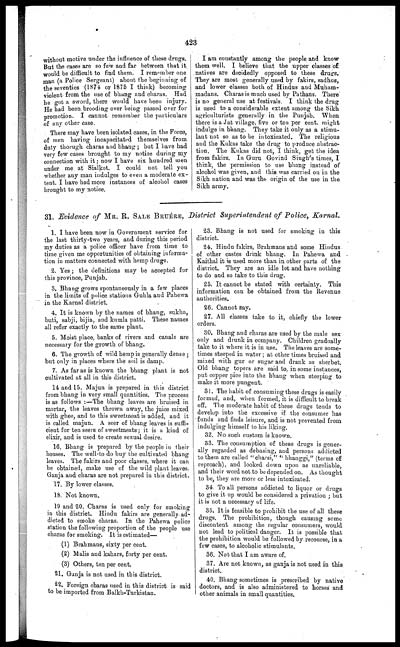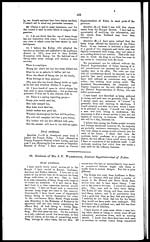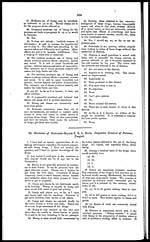Medicine - Drugs > Report of the Indian Hemp Drugs Commission, 1894-1895 > Volume V
(443) Page 423
Download files
Individual page:
Thumbnail gallery: Grid view | List view

423
without motive under the influence of: these drugs.
But the cases are so few and far between that it
would be difficult to find them. I remember one
man (a Police Sergeant) about the beginning of
the seventies (1874 or 1875 I think) becoming
violent from the use of bhang and charas. Had
he got a sword, there would have been injury.
He had been brooding over being passed over for
promotion. I cannot remember the particulars
of any other case.
There may have been isolated cases, in the Force,
of men having incapacitated themselves from
duty thorugh charas and bhang ; but I have had
very few cases brought to my notice during my
connection with it; now I have six hundred men
under me at Sialkot. I could not tell you
whether any man indulges to even a moderate ex-
tent. I have had more instances of alcohol cases
brought to my notice.
I am constantly among the people and know
them well. I believe that the upper classes of
natives are decidedly opposed to these drugs.
They are most generally used by fakirs, sadhus,
and lower classes both of Hindus and Muham-
madans. Charas is much used by Pathans. There
is no general use at festivals. I think the drug
is used to a considerable extent among the Sikh
agriculturists generally in the Punjab. When
there is a Jat village, five or ten per cent. might
indulge in bhang. They take it only as a stimu-
lant not so as to be intoxicated. The religious
and the Kukas take the drug to produce abstrac-
tion. The Kukas did not, I think, get the idea
from fakirs. In Guru Govind Singh's times, I
think, the permission to use bhang instead of
alcohol was given, and this was carried on in the
Sikh nation and was the origin of the use in the
Sikh army.
31. Evidence of MR. R. SALE BRUÉRE, District Superintendent of Police, Karnal .
1. I have been now in Government service for
the last thirty-two years, and during this period
my duties as a police officer have from time to
time given me opportunities of obtaining informa-
tion in matters connected with hemp drugs.
2. Yes; the definitions may be accepted for
this province, Punjab.
3. Bhang grows spontaneously in a few places
in the limits of police stations Guhla and Pahewa
in the Karnal district.
4. It is known by the names of bhang, sukha,
buti, sabji, bijia, and kumla patti. These names
all refer exactly to the same plant.
5. Moist place, banks of rivers and canals are
necessary for the growth of bhang.
6. The growth of wild hemp is generally dense ;
but only in places where the soil is damp.
7. As far as is known the bhang plant is not
cultivated at all in this district.
14 and 15. Majun is prepared in this district
from bhang in very small quantities. The process
is as follows :—The bhang leaves are bruised in
mortar, the leaves thrown away, the juice mixed
with ghee, and to this sweetmeat is added, and it
is called majun. A seer of bhang leaves is suffi-
cient for ten seers of sweetmeats; it is a kind of
elixir, and is used to create sexual desire.
16. Bhang is prepared by the people in their
houses. The well-to do buy the cultivated bhang
leaves. The fakirs and poor classes, where it can
be obtained, make use of the wild plant leaves.
Ganja and charas are not prepared in this district.
17. By lower classes.
18. Not known.
19 and 20. Charas is used only for smoking
in this district. Hindu fakirs are generally ad-
dicted to smoke charas. In the Pahewa police
station the following proportion of the people use
charas for smoking. It is estimated—
(1) Brahmans, sixty per cent.
(2) Malis and kahars, forty per cent.
(3) Others, ten per cent.
21. Ganja is not used in this district.
22. Foreign charas used in this district is said
to be imported from Balkh-Turkistan.
23. Bhang is not used for smoking in this
district.
24. Hindu fakirs, Brahmans and some Hindus
of other castes drink bhang. In Pahewa and
Kaitkal it is used more than in other parts of the
district. They are an idle lot and have nothing
to do and so take to this drug.
25. It cannot be stated with certainty. This
information can be obtained from the Revenue
authorities.
26. Cannot say.
27. All classes take to it, chiefly the lower
orders.
30. Bhang and charas are used by the male sex
only and drunk in company. Children gradually
take to it where it is in use. The leaves are some-
times steeped in water ; at other times bruised and
mixed with gur or sugar and drank as sherbet.
Old bhang topers are said to, in some instances,
put copper pice into the bhang when steeping to
make it more pungent.
31. The habit of consuming these drugs is easily
formed, and, when formed, it is difficult to break
off. The moderate habit of these drugs tends to
develop into the excessive if the consumer has
funds and finds leisure, and is not prevented from
indulging himself to his liking.
32. No such custom is kuown.
33. The consumption of these drugs is gener-
ally regarded as debasing, and persons addicted
to them are called "charsi," " bhanggi," (terms of
reproach), and looked down upon as unreliable,
and their word not to be depended on. As thought
to be, they are more or less intoxicated.
34. To all persons addicted to liquor or drugs
to give it up would be considered a privation ; but
it is not a necessary of life.
35. It is feasible to prohibit the use of all these
drugs. The prohibition, though causing some
discontent among the regular consumers, would
not lead to political danger. It is possible that
the prohibition would be followed by recourse, in a
few cases, to alcoholic stimulants.
36. Not that I am aware of.
37. Are not known, as ganja is not used in this
district.
40. Bhang sometimes is prescribed by native
doctors, and is also administered to horses and
other animals in small quantities.
Set display mode to: Large image | Zoom image | Transcription
Images and transcriptions on this page, including medium image downloads, may be used under the Creative Commons Attribution 4.0 International Licence unless otherwise stated. ![]()
| India Papers > Medicine - Drugs > Report of the Indian Hemp Drugs Commission, 1894-1895 > Volume V > (443) Page 423 |
|---|
| Permanent URL | https://digital.nls.uk/75122177 |
|---|
| Description | Volume 5: Evidence of witnesses from North-Western Provinces and Oudh and Punjab. Answers from witnesses in North-Western Provinces, Oudh and Punjab about cultivation and growth of hemp, preparation or manufacture, trade, consumption or use, effects, administration - taxation and control. |
|---|---|
| Attribution and copyright: |
|




